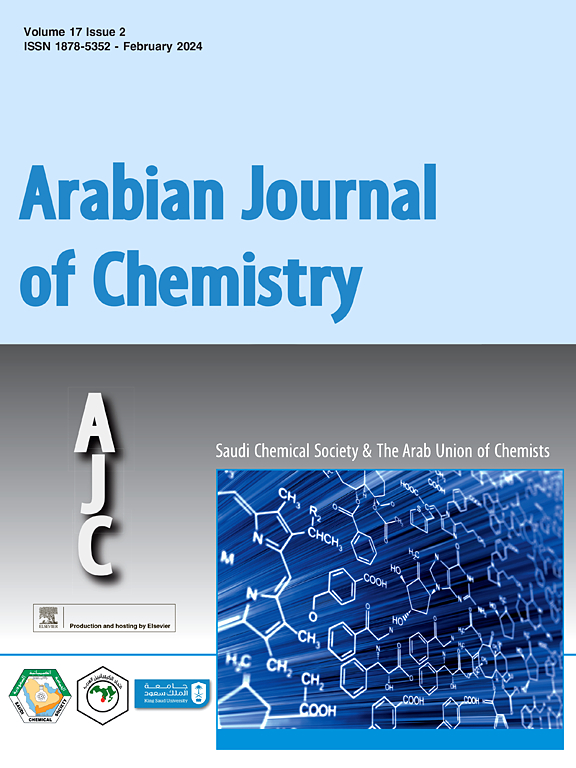利用注入氧化镁的粘土和过氧化氢的超声波活化,增强对乙酰氨基酚的催化降解能力
IF 5.2
2区 化学
Q2 CHEMISTRY, MULTIDISCIPLINARY
引用次数: 0
摘要
本研究使用氧化镁(MgO)修饰的粘土作为催化剂,在过氧化氢(H2O2)和超声波的作用下降解废水中的对乙酰氨基酚。使用 TGA、XRD、BET、SEM、傅里叶变换红外光谱、XRF 和 EDX 对粘土-氧化镁催化剂进行了表征,发现了能够活化 H2O2 的官能团。在 500 °C 下合成的结晶催化剂的表面积为 30 m2/g。去除对乙酰氨基酚的最佳条件为 pH 值 8、3 g/L 催化剂、0.2 mL/100 mL H2O2 和 60 分钟的接触时间,去除效率为 75%。在蒸馏水中,对乙酰氨基酚的矿化度为 42%,而实际废水的矿化度为 18%。羟基自由基在降解过程中发挥了重要作用。经测试,该催化剂可重复使用六次,并在五个阶段中保持了 53% 以上的高效率。自由基清除剂研究证实了羟基自由基在降解动力学中的重要性,降解动力学遵循伪一阶(R2 > 0.96)和 Langmuir-Hinshelwood (R2 = 0.95)模型。该催化剂还能在包括海水在内的复杂溶液中高效去除对乙酰氨基酚。这种氧化镁改性粘土有望成为一种有效的催化剂,通过过氧化氢活化降解制药污染物,并在多次循环中保持稳定性和可重复使用性。本文章由计算机程序翻译,如有差异,请以英文原文为准。
Enhanced catalytic degradation of acetaminophen using magnesium oxide-infused clay with ultrasonic activation of hydrogen peroxide
In this study, clay modified with magnesium oxide (MgO) was used as a catalyst for the degradation of acetaminophen in wastewater, activated by hydrogen peroxide (H2O2) and ultrasonic waves. Characterization of the Clay-MgO catalyst was conducted using TGA, XRD, BET, SEM, FTIR, XRF, and EDX, revealing functional groups capable of activating H2O2. The crystalline catalyst, synthesized at 500 °C, had a surface area of 30 m2/g. Optimal conditions for acetaminophen removal, achieving 75 % efficiency, were pH 8, 3 g/L catalyst, 0.2 mL/100 mL H2O2, and 60 min of contact time. In distilled water, mineralization of acetaminophen was 42 %, while actual wastewater showed 18 %. Hydroxyl radicals played a significant role in the degradation process. The catalyst was tested for reuse up to six times and maintained a high efficiency of over 53 % in five stages. Radical scavenger studies confirmed the importance of hydroxyl radicals in the degradation kinetics, which followed pseudo-first-order (R2 > 0.96) and Langmuir-Hinshelwood (R2 = 0.95) models. The catalyst also demonstrated efficient acetaminophen removal in complex solutions, including seawater. This MgO-modified clay shows promise as an effective catalyst for the degradation of pharmaceutical pollutants through hydrogen peroxide activation, maintaining stability and reusability across multiple cycles.
求助全文
通过发布文献求助,成功后即可免费获取论文全文。
去求助
来源期刊

Arabian Journal of Chemistry
CHEMISTRY, MULTIDISCIPLINARY-
CiteScore
10.80
自引率
3.30%
发文量
763
审稿时长
63 days
期刊介绍:
The Arabian Journal of Chemistry is an English language, peer-reviewed scholarly publication in the area of chemistry. The Arabian Journal of Chemistry publishes original papers, reviews and short reports on, but not limited to: inorganic, physical, organic, analytical and biochemistry.
The Arabian Journal of Chemistry is issued by the Arab Union of Chemists and is published by King Saud University together with the Saudi Chemical Society in collaboration with Elsevier and is edited by an international group of eminent researchers.
 求助内容:
求助内容: 应助结果提醒方式:
应助结果提醒方式:


